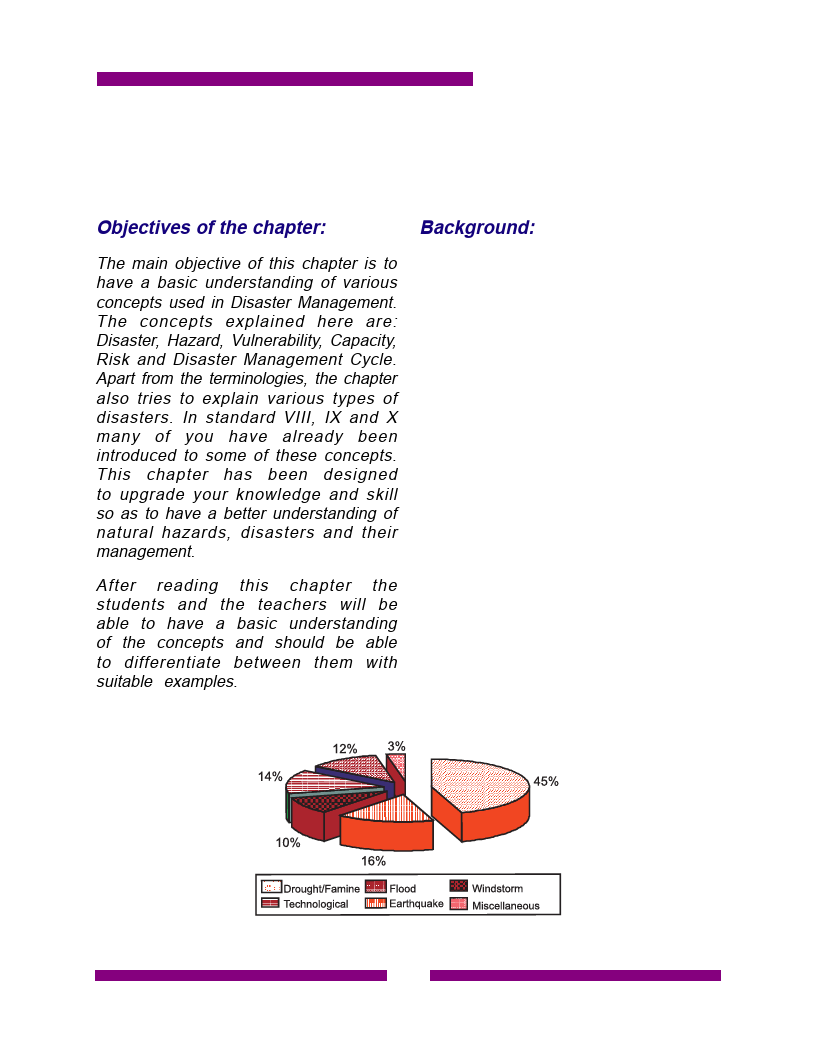
Natural Hazards & Disaster Management
Chapter 1
INTRODUCTION TO DISASTER MANAGEMENT
Objectives of the chapter:
Background:
The main objective of this chapter is to
have a basic understanding of various
concepts used in Disaster Management.
The concepts explained here are:
Disaster, Hazard, Vulnerability, Capacity,
Risk and Disaster Management Cycle.
Apart from the terminologies, the chapter
also tries to explain various types of
disasters. In standard VIII, IX and X
many of you have already been
introduced to some of these concepts.
This chapter has been designed
to upgrade your knowledge and skill
so as to have a better understanding of
natural hazards, disasters and their
management.
After reading this chapter the
students and the teachers will be
able to have a basic understanding
of the concepts and should be able
to differentiate between them with
suitable examples.
The global context:
Disasters are as old as human history but
the dramatic increase and the damage
caused by them in the recent past have
become a cause of national and international
concern. Over the past decade, the number
of natural and manmade disasters has
climbed inexorably. From 1994 to 1998,
reported disasters average was 428 per year
but from 1999 to 2003, this figure went up to
an average of 707 disaster events per year
showing an increase of about 60 per cent
over the previous years. The biggest rise was
in countries of low human development,
which suffered an increase of 142 per cent.
The figure 1.1 shows the deadliest disasters
of the decade (1992 – 2001). Drought and
famine have proved to be the deadliest
disasters globally, followed by flood,
technological disaster, earthquake, winds-
torm, extreme temperature and others. Global
economic loss related to disaster events
average around US $880 billion per year.
Fig : 1.1 World Scenario: Reported Deaths from all
Disasters (1992-2001)
1
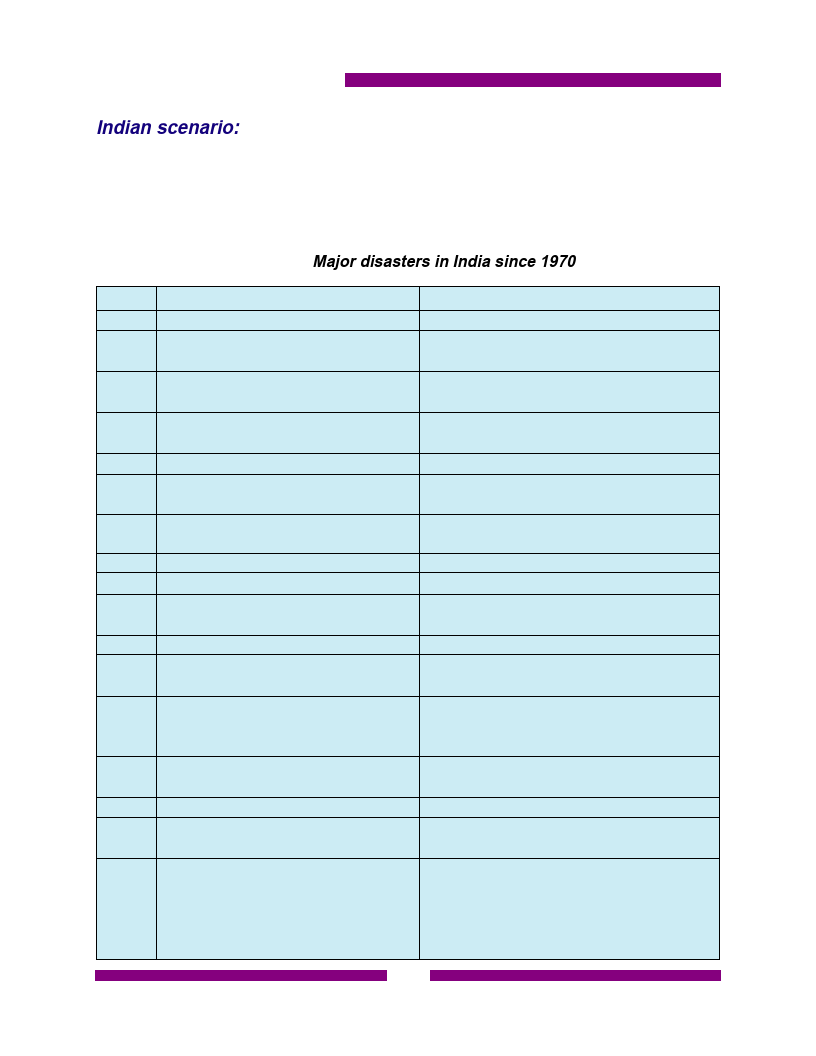
Natural Hazards & Disaster Management
Indian scenario:
The scenario in India is no different from
the global context. The super cyclone of
Orissa (1999), the Gujarat earthquake
(2001) and the recent Tsunami (2004)
affected millions across the country
leaving behind a trail of heavy loss of life,
property and livelihood. Table 1.1 shows
a list of some of the major disasters that
have caused colossal impact on the
community.
Table 1.1 Major disasters in India since 1970
Sl. No
Disaster
Cyclone
1
29th October 1971, Orissa
2
19th November, 1977,
Andhra Pradesh
3
29th and 30th October 1999,
Orissa
Earthquake
4
20th October 1991 Uttarkashi
5
30th September 1993 Latur
6
22 May 1997 Jabalpur
7
29th March 1997, Chamoli
8
26th January, 2001, Bhuj,
Gujarat
Landslide
9
July 1991, Assam
10
August 1993, Nagaland
11
18th August 1998, Malpa
Flood
12
1978 Floods in North East India
13
1994 Floods in Assam,
Arunachal Pradesh, Jammu and
Kashmir, Himachal Pradesh,
Panjab, Uttar Pradesh, Goa,
Kerala and Gujarat
Impact
Cyclone and tidal waves killed 10,000
people
Cyclone and tidal waves killed 20,000
people
Cyclone and tidal waves killed 9,000 and
18 million people were affected
An earthquake of magnitude 6.6 killed
723 people
Approximately 8000 people died and
there was a heavy loss to infrastructure
39 people dead
100 people dead
More than 10,000 dead and heavy loss
to infrastructure
300 people killed, heavy loss to roads
and infrastructure
500 killed and more than 200 houses
destroyed and about 5kms. Road
damaged.
210 people killed. Villages were washed
away
3,800 people killed and heavy loss to
property.
More than 2000 people killed and
thousands affected
2
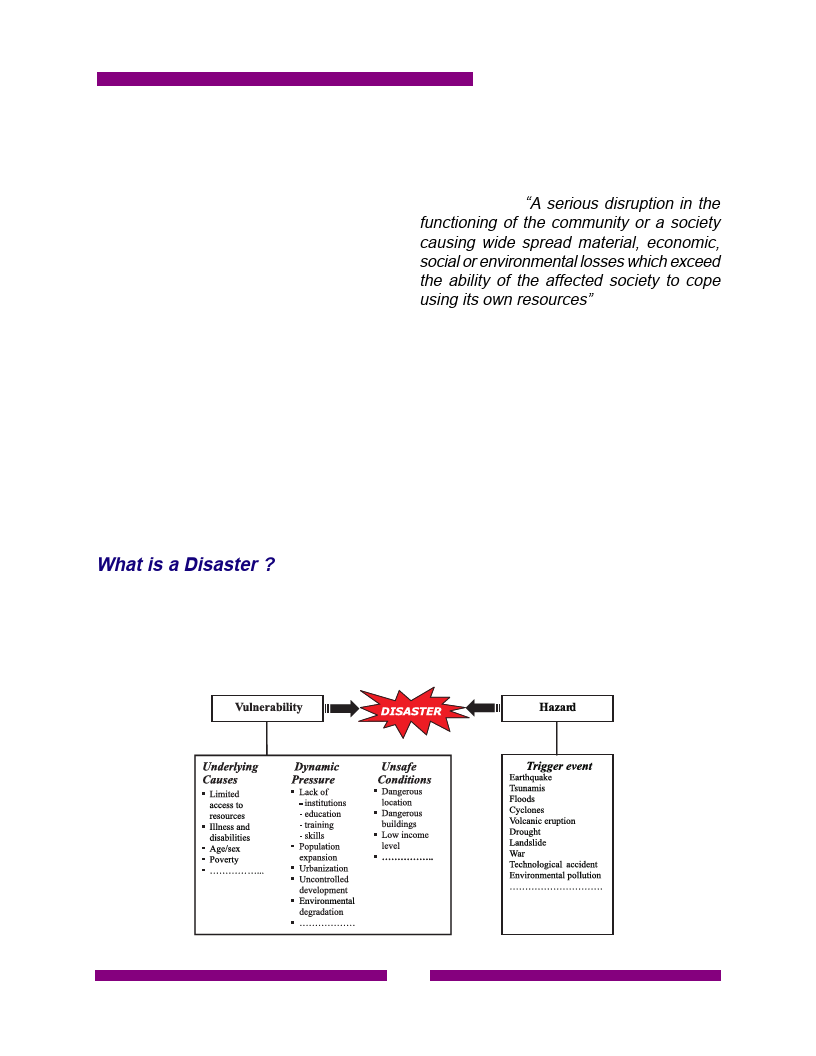
Natural Hazards & Disaster Management
While studying about the impact we need to
be aware of potential hazards, how, when
and where they are likely to occur, and the
problems which may result of an event. In
India, 59 per cent of the land mass is
susceptible to seismic hazard; 5 per cent of
the total geographical area is prone to floods;
8 per cent of the total landmass is prone to
cyclones; 70 per cent of the total cultivable
area is vulnerable to drought. Apart from this
the hilly regions are vulnerable to avalanches/
landslides/hailstorms/cloudbursts. Apart from
the natural hazards, we need to know about
the other manmade hazards which are
frequent and cause huge damage to life and
property. It is therefore important that we are
aware of how to cope with their effects.
We have seen the huge loss to life, property
and infrastructure a disaster can cause but
let us understand what is a disaster, what
are the factors that lead to it and its impact.
What is a Disaster ?
Almost everyday, newspapers, radio and
television channels carry reports on disaster
striking several parts of the world. But what
is a disaster? The term disaster owes its
origin to the French word “Desastre” which
is a combination of two words ‘des’ meaning
bad and ‘aster’ meaning star. Thus the term
refers to ‘Bad or Evil star’. A disaster can
be defined as “A serious disruption in the
functioning of the community or a society
causing wide spread material, economic,
social or environmental losses which exceed
the ability of the affected society to cope
using its own resources”.
A disaster is a result from the combination
of hazard, vulnerability and insufficient
capacity or measures to reduce the potential
chances of risk.
A disaster happens when a hazard impacts
on the vulnerable population and causes
damage, casualties and disruption. Fig: 1.2
would give a better illustration of what a
disaster is. Any hazard – flood, earthquake
or cyclone which is a triggering event along
with greater vulnerability (inadequate access
to resources, sick and old people, lack of
awareness etc) would lead to disaster
causing greater loss to life and property. For
example; an earthquake in an uninhabited
desert cannot be considered a disaster, no
matter how strong the intensities produced.
Fig: 1.2
3
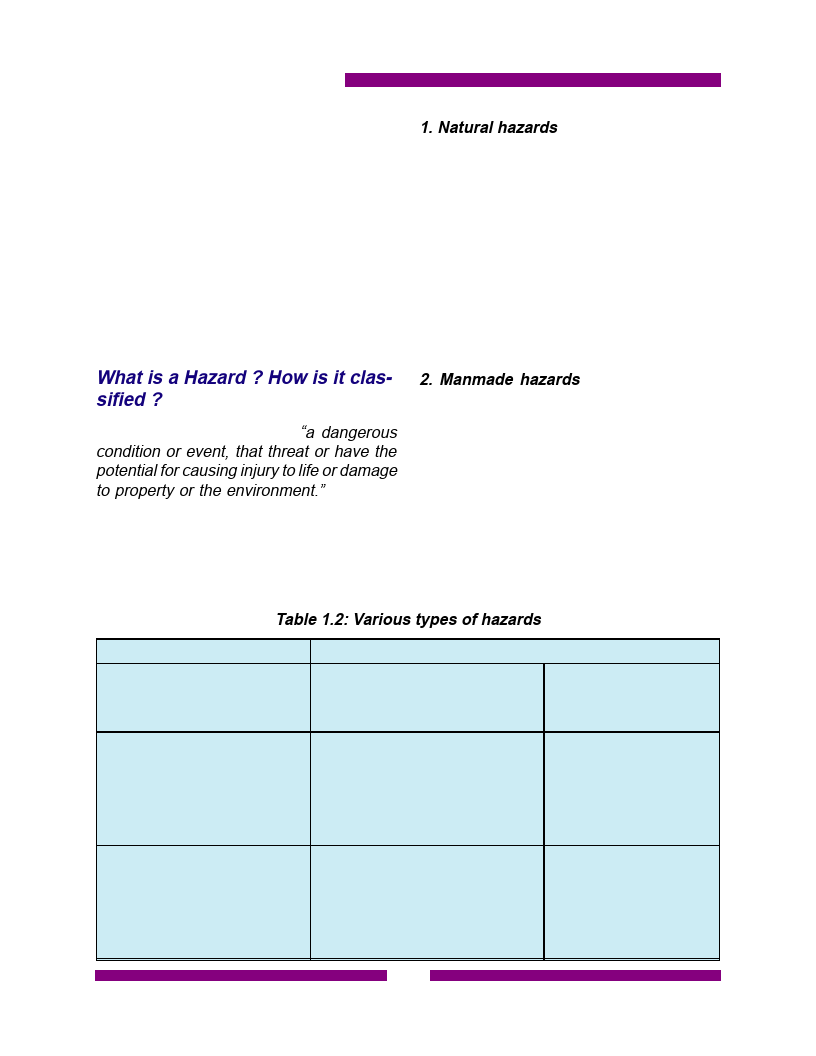
Natural Hazards & Disaster Management
An earthquake is disastrous only when it
affects people, their properties and activities.
Thus, disaster occurs only when hazards
and vulnerability meet. But it is also to be
noted that with greater capacity of the
individual/community and environment to
face these disasters, the impact of a hazard
reduces. Therefore, we need to understand
the three major components namely hazard,
vulnerability and capacity with suitable
examples to have a basic understanding of
disaster management.
What is a Hazard ? How is it clas-
sified ?
Hazard may be defined as “a dangerous
condition or event, that threat or have the
potential for causing injury to life or damage
to property or the environment.” The word
‘hazard’ owes its origin to the word ‘hasard’
in old French and ‘az-zahr’ in Arabic
meaning ‘chance’ or ‘luck’. Hazards can be
grouped into two broad categories namely
natural and manmade.
1. Natural hazards are hazards which are
caused because of natural phenomena
(hazards with meteorological, geological or
even biological origin). Examples of natural
hazards are cyclones, tsunamis, earth-
quake and volcanic eruption which are
exclusively of natural origin. Landslides,
floods, drought, fires are socio-natural
hazards since their causes are both natural
and man made. For example flooding may
be caused because of heavy rains, landslide
or blocking of drains with human waste.
2. Manmade hazards are hazards which
are due to human negligence. Manmade
hazards are associated with industries or
energy generation facilities and include
explosions, leakage of toxic waste, pollution,
dam failure, wars or civil strife etc.
The list of hazards is very long. Many occur
frequently while others take place
occasionally. However, on the basis of their
genesis, they can be categorized as
follows:
Table 1.2: Various types of hazards
Types
Geological Hazards
Water & Climatic Hazards
Environmental Hazards
Biological
Hazards
1. Earthquake
2. Tsunami
3. Volcanic eruption
1. Tropical Cyclone
2. Tornado and Hurricane
3. Floods
4. Drought
5. Hailstorm
1. Environmental pollutions
2. Deforestation
1. Human / Animal Epidemics
2. Pest attacks
4
4. Landslide
5. Dam burst
6. Mine Fire
6. Cloudburst
7. Landslide
8. Heat & Cold wave
9. Snow Avalanche
10. Sea erosion
3. Desertification
4. Pest Infection
3. Food poisoning
4. Weapons of Mass
Destruction
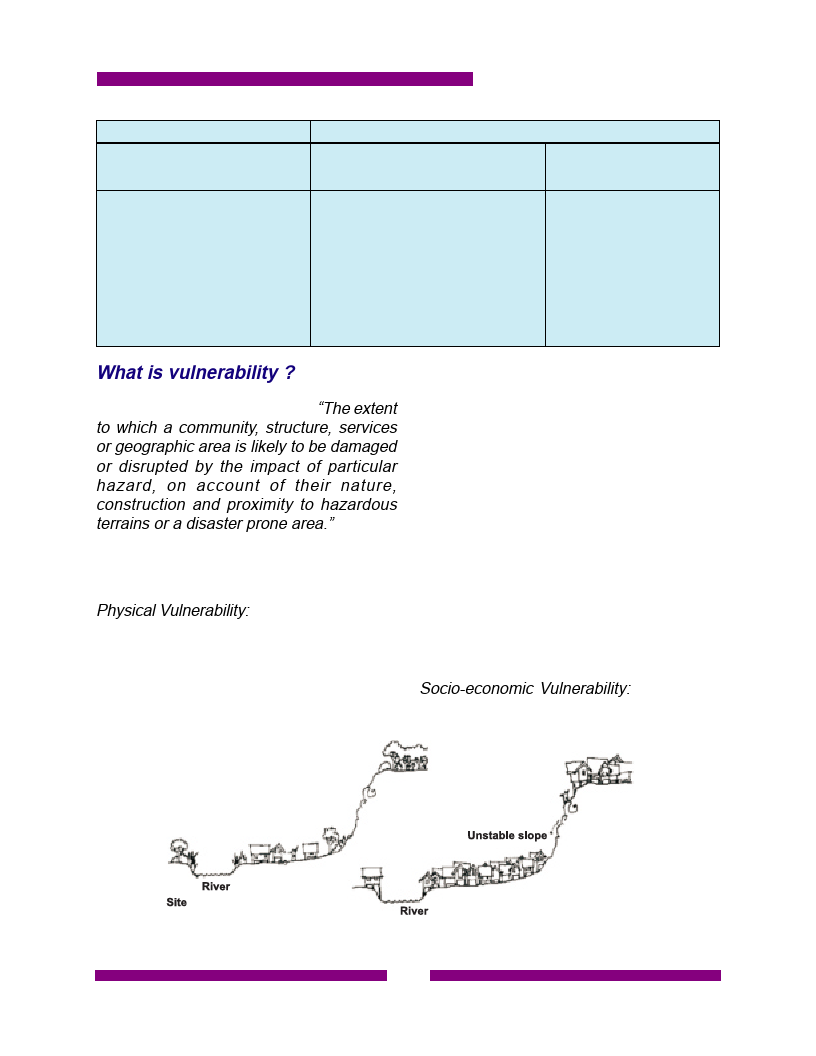
Natural Hazards & Disaster Management
Types
Chemical, Industrial and
Nuclear Accidents
Accident related
Hazards
1. Chemical disasters
2. Industrial disasters
1. Boat / Road / Train
accidents / air crash
Rural / Urban fires
Bomb /serial bomb
blasts
2. Forest fires
3. Oil spills/Fires
4. Nuclear
3. Building collapse
4. Electric Accidents
5. Festival related
disasters
6. Mine flooding
What is vulnerability ?
Vulnerability may be defined as “The extent
to which a community, structure, services
or geographic area is likely to be damaged
or disrupted by the impact of particular
hazard, on account of their nature,
construction and proximity to hazardous
terrains or a disaster prone area.”
Vulnerabilities can be categorized into
physical and socio-economic vulnerability.
Physical Vulnerability: It includes notions of
who and what may be damaged or
destroyed by natural hazard such as earth-
quakes or floods. It is based on the physical
condition of people and elements at risk,
such as buildings, infrastructure etc; and their
proximity, location and nature of the hazard.
It also relates to the technical capability of
building and structures to resist the forces
acting upon them during a hazard event.
Figure 1.3 shows the settlements which are
located in hazardous slopes. Many landslide
and flooding disasters are linked to what you
see in the figure 1.3. Unchecked growth of
settlements in unsafe areas exposes the
people to the hazard. In case of an earth-
quake or landslide the ground may fail and
the houses on the top may topple or slide
and affect the settlements at the lower level
even if they are designed well for earthquake
forces.
Socio-economic Vulnerability: The degree
to which a population is affected by a hazard
Figure 1.3 : Site after pressures from population growth and urbanization
5
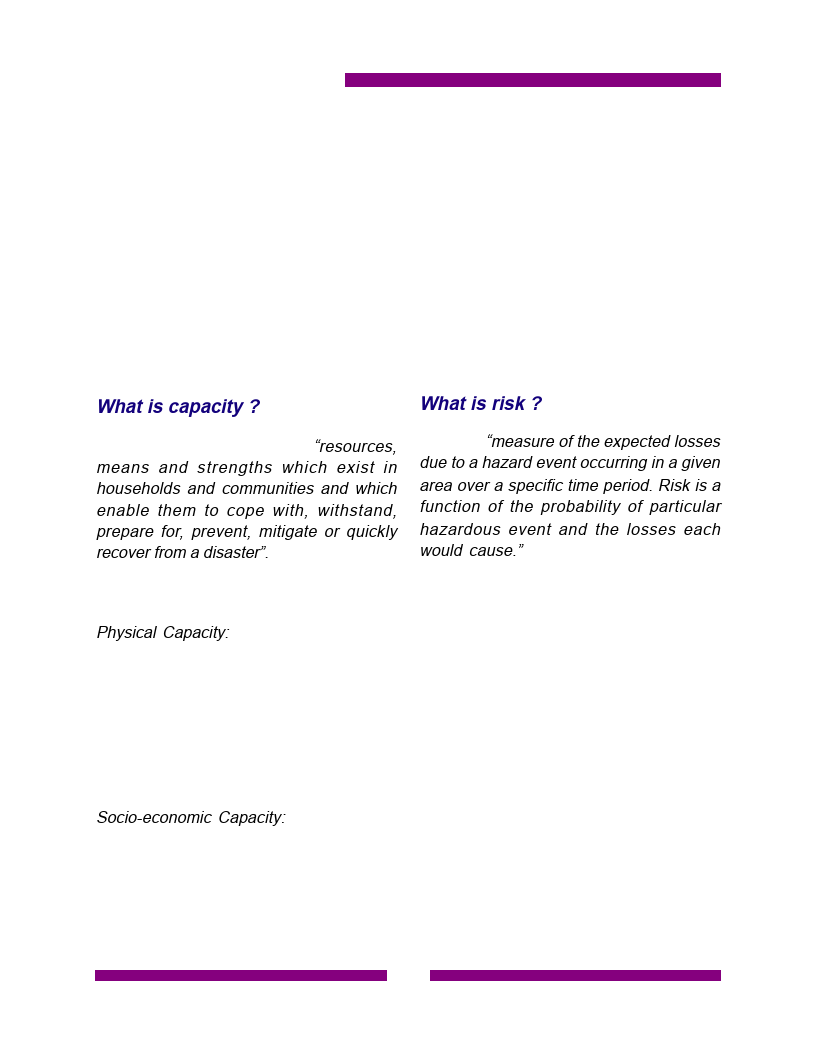
Natural Hazards & Disaster Management
will not merely lie in the physical components
of vulnerability but also on the socio-
economic conditions. The socio-economic
condition of the people also determines the
intensity of the impact. For example, people
who are poor and living in the sea coast don’t
have the money to construct strong concrete
houses. They are generally at risk and
loose their shelters when ever there is
strong wind or cyclone. Because of their
poverty they too are not able to rebuild their
houses.
safe areas and their houses are built with
stronger materials. However, even when
everything is destroyed they have the
capacity to cope up with it.
Hazards are always prevalent, but the
hazard becomes a disaster only when there
is greater vulnerability and less of capacity
to cope with it. In other words the frequency
or likelihood of a hazard and the vulnerability
of the community increases the risk of being
severely affected.
What is capacity ?
What is risk ?
Capacity can be defined as “resources,
means and strengths which exist in
households and communities and which
enable them to cope with, withstand,
prepare for, prevent, mitigate or quickly
recover from a disaster”. People’s capacity
can also be taken into account. Capacities
could be:
Physical Capacity: People whose houses
have been destroyed by the cyclone or crops
have been destroyed by the flood can
salvage things from their homes and from
their farms. Some family members have
skills, which enable them to find employment
if they migrate, either temporarily or
permanently.
Socio-economic Capacity: In most of the
disasters, people suffer their greatest losses
in the physical and material realm. Rich
people have the capacity to recover soon
because of their wealth. In fact, they are
seldom hit by disasters because they live in
Risk is a “measure of the expected losses
due to a hazard event occurring in a given
area over a specific time period. Risk is a
function of the probability of particular
hazardous event and the losses each
would cause.” The level of risk depends
upon:
y Nature of the hazard
y Vulnerability of the elements which are
affected
y Economic value of those elements
A community/locality is said to be at ‘risk’
when it is exposed to hazards and is
likely to be adversely affected by its
impact. Whenever we discuss ‘disaster
management’ it is basically ‘disaster risk
management’. Disaster risk management
includes all measures which reduce disaster
related losses of life, property or assets by
either reducing the hazard or vulnerability
of the elements at risk.
6
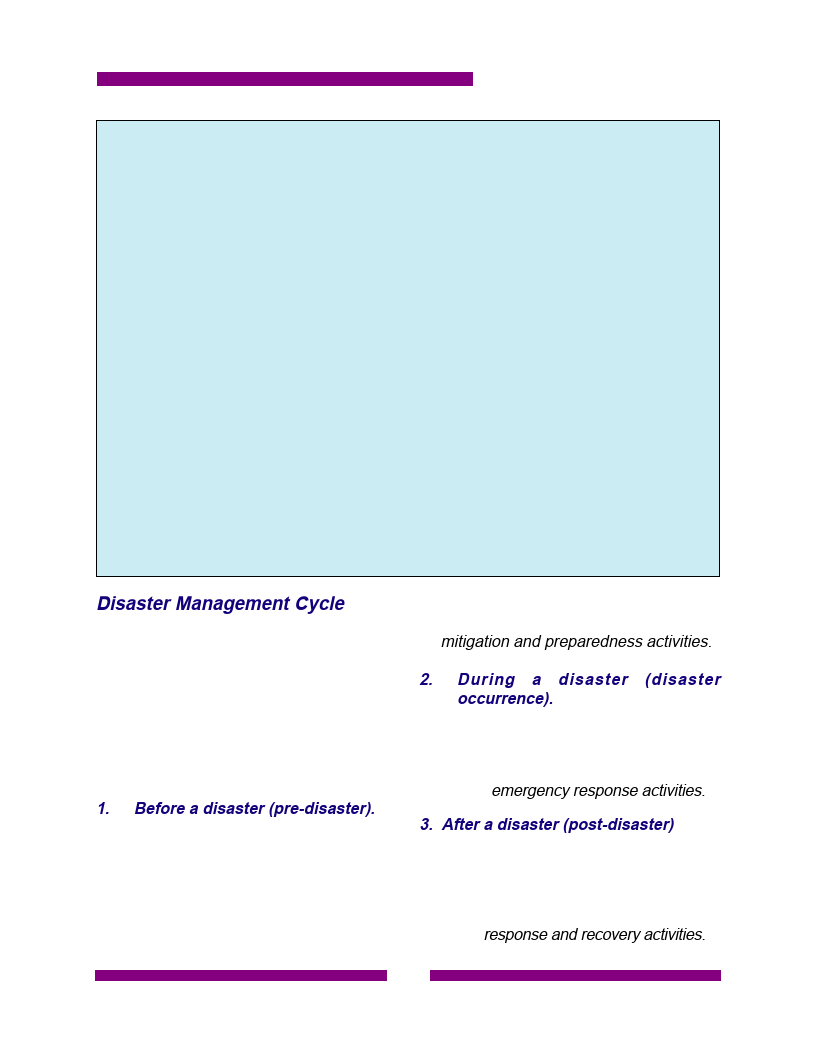
Natural Hazards & Disaster Management
Disaster Risk Reduction can take place in the following ways:
1. Preparedness
This protective process embraces measures which enable governments, communities
and individuals to respond rapidly to disaster situations to cope with them effectively.
Preparedness includes the formulation of viable emergency plans, the development
of warning systems, the maintenance of inventories and the training of personnel.
It may also embrace search and rescue measures as well as evacuation plans for
areas that may be at risk from a recurring disaster.
Preparedness therefore encompasses those measures taken before a disaster event
which are aimed at minimising loss of life, disruption of critical services, and damage
when the disaster occurs.
2. Mitigation
Mitigation embraces measures taken to reduce both the effect of the hazard and the
vulnerable conditions to it in order to reduce the scale of a future disaster. Therefore
mitigation activities can be focused on the hazard itself or the elements exposed to
the threat. Examples of mitigation measures which are hazard specific include water
management in drought prone areas, relocating people away from the hazard prone
areas and by strengthening structures to reduce damage when a hazard occurs.
In addition to these physical measures, mitigation should also aim at reducing the
economic and social vulnerabilities of potential disasters
Disaster Management Cycle
Disaster Risk Management includes sum
total of all activities, programmes and
measures which can be taken up before,
during and after a disaster with the purpose
to avoid a disaster, reduce its impact or
recover from its losses. The three key stages
of activities that are taken up within disaster
risk management are:
1. Before a disaster (pre-disaster).
Activities taken to reduce human and
property losses caused by a potential
hazard. For example carrying out aware-
ness campaigns, strengthening the existing
weak structures, preparation of the disaster
management plans at household and
community level etc. Such risk reduction
measures taken under this stage are termed
as mitigation and preparedness activities.
2. During a disaster (disaster
occurrence).
Initiatives taken to ensure that the needs and
provisions of victims are met and suffering is
minimized. Activities taken under this stage
are called emergency response activities.
3. After a disaster (post-disaster)
Initiatives taken in response to a disaster
with a purpose to achieve early recovery and
rehabilitation of affected communities,
immediately after a disaster strikes. These are
called as response and recovery activities.
7
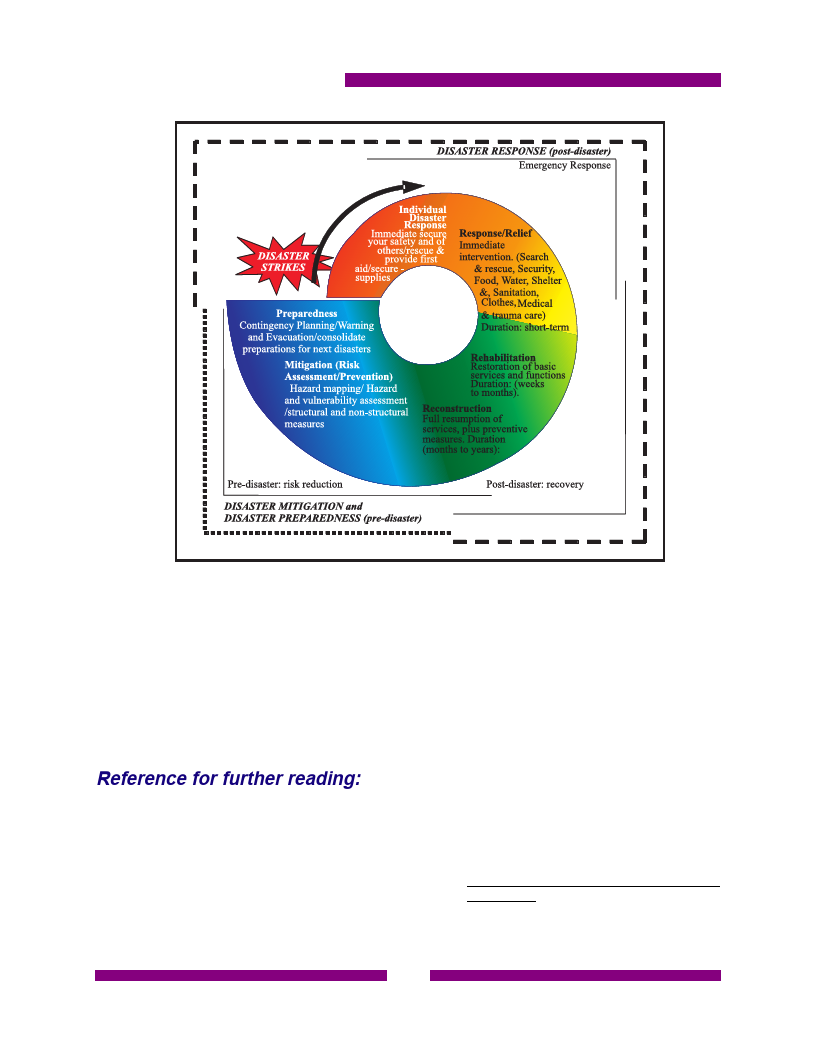
Natural Hazards & Disaster Management
Reference: Are you prepared? Learning from the Great Hanshin-Awaji
Earthquake Disaster - Handbook for Disaster Reduction and Volunteer activities
Figure 1.4 : Disaster Management
In the subsequent chapters we would
discuss in detail some of the major hazards
prevalent in our country its causes, impact, 3.
preparedness and mitigation measures that
need to be taken up.
4.
Reference for further reading:
1.
Reading materials of 11th Community Based 5.
Disaster Risk Management Course,
Bangkok, Thailand July 21 – August 1, 2003.
2.
Anderson, M. and P. Woodrow. 1989. Rising 6.
from the Ashes: Development Strategies in
Times of Disaster. UNESCO and West view
Press, Inc., Colorado.
Anderson M. Vulnerability to Disaster and
Sustainable Development: A General
Framework for Assessing Vulnerability.
UNDP Disaster Management Training
Programme.1992. An Overview of Disaster
Management.
International Federation of Red Crescent
Societies World Disaster Report: Focus on
Community resilience.
http://www.unisdr.org/eng/library/lib-
terminology
8

Natural Hazards & Disaster Management
Exercise
3)
1) Explain with examples the difference
between hazard, and vulnerability. How
does capacity influence vulnerability? 4)
2) Explain in detail the vulnerability
profile of our country.
Define risk and suggest two ways of
reducing risk with appropriate
examples.
Briefly discuss the Disaster
Management Cycle with suitable
examples.
9




